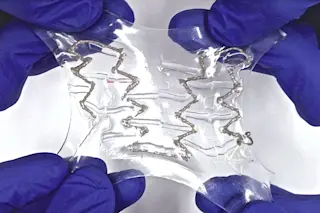Researchers' solar-charged battery system merges function and comfort. (Credit: Zamarayeva et al., Sci. Adv. 2017;3: e1602051) Incorporating electronic components into everything we wear is the fashion trend of the future. But those LEDs, health sensors, heaters and whatever else we’ll come up with all need energy. A battery is a logical solution, but it’s been difficult to design one that’s rugged and efficient, but also comfortable. However, in a study published today in Science Advances, a team from the University of California, Berkeley described a battery that perhaps satisfies all of those parameters. The battery is made out of springs and charged by an integrated solar cell. The battery's unprecedented tolerance to repeated bending and ability to bend in any direction makes it well suited for integration into wearable electronics such as health monitors. Aminy Ostfeld, a post-doc at Berkeley, says the project emerged from the question, “What is the ...
Bendable, Stretchable Batteries Provide a Jump Start for Wearable Tech
Discover the innovative solar-charged battery system that enhances wearable electronics integration with improved comfort and flexibility.
More on Discover
Stay Curious
SubscribeTo The Magazine
Save up to 40% off the cover price when you subscribe to Discover magazine.
Subscribe













